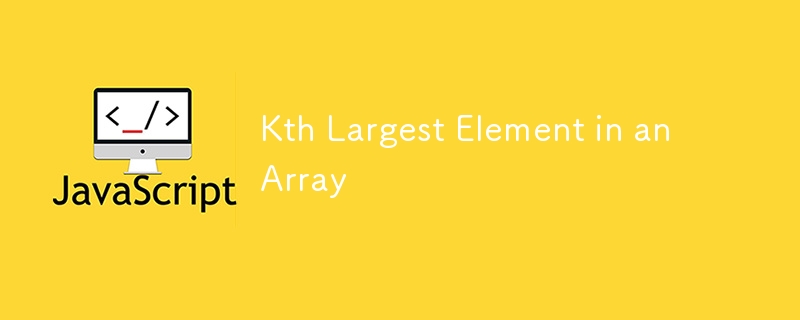

https://leetcode.com/problems/kth-largest-element-in-an-array/description
Wenn das Array [8, 6, 12, 9, 3, 4] ist und k 2 ist, müssen Sie das zweitgrößte Element in diesem Array finden. Zuerst sortieren Sie das Array: [3, 4, 6, 8, 9, 12] Die Ausgabe ist 9, da es das zweitgrößte Element ist.
var findKthLargest = function(nums, k) {
// Sort the array in ascending order
nums.sort((a, b) => a - b);
// Return the kth largest element
return nums[nums.length - k];
};
Die Gesamtzeitkomplexität beträgt also O(n log n).
var findKthLargest = function(nums, k) {
// Create a min-heap using a priority queue
let minHeap = new MinPriorityQueue();
// Add the first k elements to the heap
for (let i = 0; i < k; i++) {
//minHeap.enqueue(nums[i]): Adds the element nums[i] to the min-heap.
minHeap.enqueue(nums[i]);
}
// Iterate through the remaining elements
for (let i = k; i < nums.length; i++) {
//minHeap.front().element: Retrieves the smallest element in the min-heap without removing it.
if (minHeap.front().element < nums[i]) {
// minHeap.dequeue(): Removes the smallest element from the min-heap.
minHeap.dequeue();
// Add the current element
minHeap.enqueue(nums[i]);
}
}
// The root of the heap is the kth largest element
return minHeap.front().element;
};
Aktuelles Element = 3
Aktuelles Element = 5
Aktuelles Element = 4
Hinweis: Auch wenn Leetcode die Schnellauswahl einschränkt, sollten Sie sich an diesen Ansatz erinnern, da er die meisten Testfälle besteht
//Quick Select Algo
function quickSelect(list, left, right, k)
if left = right
return list[left]
Select a pivotIndex between left and right
pivotIndex := partition(list, left, right,
pivotIndex)
if k = pivotIndex
return list[k]
else if k < pivotIndex
right := pivotIndex - 1
else
left := pivotIndex + 1
var findKthLargest = function(nums, k) {
// Call the quickSelect function to find the kth largest element
return quickSelect(nums, 0, nums.length - 1, nums.length - k);
};
function quickSelect(nums, low, high, index) {
// If the low and high pointers are the same, return the element at low
if (low === high) return nums[low];
// Partition the array and get the pivot index
let pivotIndex = partition(nums, low, high);
// If the pivot index is the target index, return the element at pivot index
if (pivotIndex === index) {
return nums[pivotIndex];
} else if (pivotIndex > index) {
// If the pivot index is greater than the target index, search in the left partition
return quickSelect(nums, low, pivotIndex - 1, index);
} else {
// If the pivot index is less than the target index, search in the right partition
return quickSelect(nums, pivotIndex + 1, high, index);
}
}
function partition(nums, low, high) {
// Choose the pivot element
let pivot = nums[high];
let pointer = low;
// Rearrange the elements based on the pivot
for (let i = low; i < high; i++) {
if (nums[i] <= pivot) {
[nums[i], nums[pointer]] = [nums[pointer], nums[i]];
pointer++;
}
}
// Place the pivot element in its correct position
[nums[pointer], nums[high]] = [nums[high], nums[pointer]];
return pointer;
}
Das obige ist der detaillierte Inhalt vonK-tes größtes Element in einem Array. Für weitere Informationen folgen Sie bitte anderen verwandten Artikeln auf der PHP chinesischen Website!
 Implementierungsmethode für die Python-Online-Wiedergabefunktion
Implementierungsmethode für die Python-Online-Wiedergabefunktion
 PR-Tastenkombination
PR-Tastenkombination
 So öffnen Sie HTML-Dateien auf dem iPad
So öffnen Sie HTML-Dateien auf dem iPad
 So lösen Sie das Problem, das Einschaltkennwort eines Win8-Computers zu vergessen
So lösen Sie das Problem, das Einschaltkennwort eines Win8-Computers zu vergessen
 Häufig verwendete Linux-Befehle
Häufig verwendete Linux-Befehle
 Was soll ich tun, wenn sich mein Computer nicht einschalten lässt?
Was soll ich tun, wenn sich mein Computer nicht einschalten lässt?
 Ordner unter Linux löschen
Ordner unter Linux löschen
 CAD-Zeilenbruchbefehl
CAD-Zeilenbruchbefehl




